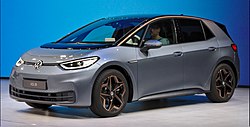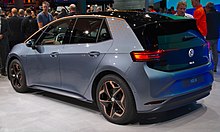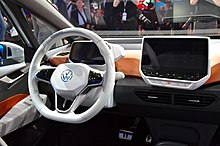VW ID.3
| Volkswagen | |
|---|---|
|
VW ID.3 at the IAA 2019
|
|
| ID.3 | |
| Production period: | since 11/2019 |
| Class : | Compact class |
| Body versions : | Station wagon |
| Engines: | Electric motor: 150 kW |
| Length: | 4261 mm |
| Width: | 1809 (without exterior mirror) or 2070 (with exterior mirror) mm |
| Height: | 1568 mm |
| Wheelbase : | 2770 mm |
| Empty weight : | 1794 kg |

The VW ID.3 ( [ faʊveː aɪdiː dʁaɪ̯ ] ) is the first car from Volkswagen designed purely as an electric car . The official presentation took place on September 9, 2019 at the IAA in Frankfurt . The ID.3 is the first series vehicle based on the modular electric drive kit (MEB). In the MEB, which was specially designed for electric cars, the drive battery is installed flat in the vehicle floor. The ID.3 is based on the VW ID concept vehicle , which is the first vehicle in the ID.family .
Naming
After the successful VW Beetle and VW Golf models , the ID.3 should be the third big chapter in the company's history. In addition, the number “3” stands for the compact class , the third level in the usual division of vehicle classes . ID is the abbreviation for "Intelligent Design".
Reservation
On May 8, 2019, VW started a reservation campaign called “Pre-Booking” for the ID.3 1 ST special model, which is limited to 30,000 copies worldwide ; a (refundable) deposit of 1000 euros was required for this. This model has been upgraded and comes with a 58 kWh battery with a range of up to 420 kilometers. At the beginning of September 2019, VW published that 30,000 registrations had been received and that the ID.3-1 ST special edition was "sold out"; Registered interested parties could reserve one of the special editions offered until October 9th. It is still possible to reserve the ID.3 series model. Binding orders can be placed since June 17, 2020. The limited special model ID.3 1 ST costs 39,995 euros (Pro), 45,995 euros (Plus) or 49,995 (Max) before discount and promotion, depending on the version. The first cars will be delivered from September 2020.
production
Production started on November 4, 2019 at the Zwickau plant . A second assembly line was planned for April 2020. Volkswagen confirmed the construction of the first 400 pre-series vehicles on September 6, 2019. From 2021 Volkswagen plans to also manufacture the ID.3 in the Transparent Factory in Dresden .
technology
drive
The VW ID.3 has rear-wheel drive . For this purpose, a permanently excited synchronous machine with an output of up to 150 kW (204 PS ) and a maximum torque of 310 Nm is installed on the rear axle . The maximum speed of the vehicle is electronically set at 160 km / h.
AVAS
Since July 1, 2019, according to a regulation of the European Parliament, newly registered electric vehicles must be audible at low speeds of up to 20 km / h by means of a warning signal or artificially generated driving noise ( Acoustic Vehicle Alerting System , AVAS for short), which switches on automatically when starting . VW uses the regulation to give the ID.3 an individual sound that distinguishes it from other electrically powered cars, and commissioned music producer Leslie Mandoki to compose a sound.
cockpit
The cockpit of the VW ID.3 consists of a display behind the steering wheel that provides all the important information for the driver (from the speedometer and battery level to navigation instructions). All controls - including those in the steering wheel - are controlled via touch functions with touch-sensitive buttons. VW only uses haptic switches for the window lifters and the hazard warning lights . There is a 10 inch touch display in the middle of the cockpit . This offers access to all important infotainment functions from music playback to navigation and air conditioning. A head-up display is available as an option.
The VW ID.3 can also be operated via voice control . He listens to the activation word "Hello, ID".
Braking system
The vehicle has internally ventilated disc brakes on the front axle and drum brakes on the rear axle as standard .
Battery and range
The production model of the ID.3 is - with regard to the capacity of the lithium-ion - drive battery and predicted ( WLTP -) Range - announced in three versions:
| battery | designation | capacity | Range | consumption | ||||
|---|---|---|---|---|---|---|---|---|
| gross | net | WLTP | appreciated in practice | WLTP | NEDC | calculated | ||
| small | Pure | 48 kWh | 45 kWh | up to 330 km | 230-330 km | 16.9-15.4 kWh ⁄ 100 km | 15.4-14.5 kWh ⁄ 100 km | 19.6–13.6 kWh ⁄ 100 km |
| medium | Per | 62 kWh | 58 kWh | up to 420 km | 300-420 km | 19.3–13.8 kWh ⁄ 100 km | ||
| big | Pro S | 82 kWh | 77 kWh | up to 550 km | 390-550 km | 19.7-14.0 kWh ⁄ 100 km | ||
A comparison of the gross with the net battery capacities shows that almost 94% of the total capacity is available for use.
The different variants differ in the number of battery modules. The battery can be actively cooled and heated via a water- glycol circuit.
Volkswagen promises a warranty on the battery of eight years or 160,000 kilometers.
The drag coefficient c w of the ID.3 is given as 0.267.
Load capacity
The ID.3 can be charged via the onboard charger with up to 11 kW (3 × 230 V, 16 A three-phase ) at a three-phase connection (medium and large battery), with the small battery 7.2 kW (16 A two-phase) ; Use of only two of the three phases of a three-phase connection) possible. You can also charge at a household socket ( Schuko ).
The maximum loading capacity of CCS - charging stations (DC) will be at the show ID.3 100 kW. As standard, vehicles with a 45 kWh battery will only have a maximum charging power of 50 kW; 100 kW will be available for a surcharge. Later, all models will also be available with a maximum charging power of 125 kW.
software
The ID.3 is the first vehicle from VW, which the new vehicle operating system vw.os uses. It controls the processors that VW designed as components of its end-to-end electronics architecture - "E3" for short. The "E3" architecture was created as part of the MEB platform. It enables updates and upgrades of the systems via the " Automotive Cloud " from VW over the life cycle of the vehicles .
Vehicles that will be delivered in 2020 should drive to the workshop once for a software update after the software has been completed . Over-the-air updates should be possible later .
Sister models

The Cupra el-Born is the sister model of the VW ID.3 and, like this one, is to be built in Zwickau in Saxony, but with a time delay compared to the start of production of the ID.3, around 2021. A concept vehicle was presented under the Seat brand at the Geneva Motor Show in March 2019 .
Measures to improve the environmental balance
production
According to Volkswagen, the production of an ID.3 produces around 50 percent more climate-damaging emissions than the production of a comparable car with a combustion engine. 43% of these emissions arise in the manufacture of the drive batteries ; if they are produced with green electricity, this percentage drops significantly. Volkswagen buys the drive batteries from LG Chem and has obliged LG Chem to use only certified green electricity in their production .
For the production of the ID.3 at the Zwickau plant, green electricity from the VW subsidiary Volkswagen Kraftwerk GmbH and its own block- type thermal power station is used in part. Further savings were achieved through process optimization, for example the consumption of natural gas was reduced in painting.
Air harmful emissions that can not be avoided during production, through climate protection projects to compensate , for example, projects for forest protection and reforestation in the tropics .
The ID.3 1 ST has been configurable on the manufacturer's side since June 17, 2020.
Usage phase
Lower emissions that are harmful to the climate compared to cars with internal combustion engines result from electric cars only when they are in use. For this it is necessary to use the largest possible proportion of green electricity . The joint venture Ionity , in which VW and several other automobile manufacturers are involved, only uses green electricity for its own charging points . With its subsidiary Volkswagen Group Charging GmbH , VW sells green electricity to private households under the Elli brand .
recycling
The recycling of drive batteries is still a major problem in electromobility. In addition to the construction of a recycling pilot plant at the Salzgitter location and the work on concepts for the second use of the drive battery, there have not yet been any concrete measures in this area for the start of production of the ID.3 were seized by VW.
literature
- Frank Kreif: Finally ID.3 - the new "Volkswagen". In: Electric Drive , No. 3/2019, pp. 26-29
- Presentation of the VW ID.3. In: Moove , No. 1/2020, pp. 52-53
Web links
- ID.3 at VW (models and configurator)
Individual evidence
- ↑ ID.3 Pre-booking - The first model of the Volkswagen ID. Family. Volkswagen News, May 9, 2019, accessed on August 21, 2020 .
- ↑ VW ID.3 (2019/2020): price, order, news, first edition, battery. Retrieved May 8, 2019 .
- ↑ E-VW ID.3: This is what the production version looks like (pictures & videos) - ecomento.de. September 10, 2019, accessed September 10, 2019 .
- ↑ The first member of the ID. Family is ID.3 , accessed October 27, 2019
- ↑ Andreas Grimm: VW has 30,000 reservations for the ID 3 First Edition. In: kfz-Betrieb . Vogel Communications Group , September 4, 2019, accessed October 9, 2019 .
- ↑ Oliver Schwuchow: VW ID.3: Volkswagen plans ID. Stores. May 14, 2020, accessed on June 6, 2020 (German).
- ↑ Stefan Moeller: VW ID.3 Price: First Edition available from 29,407 euros. In: nextmove blog . CYX Mobile KG , June 16, 2020, accessed on June 16, 2020 .
- ↑ VW electric car ID.3 will be produced from November 4th. September 6, 2019, accessed September 7, 2019 .
- ↑ Production of the ID.3 at the Zwickau plant starts in November. In: volkswagen-newsroom.com. September 6, 2019, accessed November 21, 2019 .
- ↑ Roland Hildebrandt: Volkswagen ID.4: start of production in Zwickau. In: de.motor1.com. August 20, 2020, accessed August 20, 2020 .
- ↑ This is what the ID.3 from VW sounds like . NDR.de, December 14, 2019. Retrieved December 20, 2019.
- ↑ Manuel Medicus: VW ID.3 presented: Everything about connectivity, cockpit and Co. Accessed on February 5, 2020 .
- ↑ Now you can: the new ID.3 1 ST | Electric cars | Volkswagen Germany. Retrieved May 12, 2019 .
- ↑ Auto-Motor-Sport from February 23, 2019: Price market launch photos. Retrieved May 19, 2019 .
- ↑ Calculation (according to the rule of three ): Energy consumption [ kWh ⁄ 100 km ] = 100 × net capacity [kWh] ⁄ range [km] . The actually achievable consumption values and ranges depend on many influencing factors such as B. driving style , driving speeds, road conditions, tires (pressure, profile, width), used auxiliary consumers, weather (outside temperature, wind, air pressure), load and topography.
- ↑ Show all values on the website of the ID.3
- ↑ The ID.3 celebrates its world premiere at the IAA. Volkswagen AG , August 30, 2019, accessed on September 1, 2019 .
- ↑ VW ID.3 - VW expert answers your questions! Robin TV Blau • Electromobility, August 1, 2020, accessed on August 10, 2020 .
- ↑ Jochen Wieler: VW ID.3: electric car, data, range, price. ADAC , September 10, 2019, accessed on September 28, 2019 .
- ↑ VW ID.3: First drive & innovation check - Bloch explains # 64. auto motor & sport , June 12, 2019, accessed June 13, 2019 .
- ↑ Claus-Peter Köth, Thomas Günnel: ID chassis: E-mobility for a group. In: automobil-industrie.vogel.de. Vogel Communications Group , October 9, 2018, accessed June 12, 2020 .
- ↑ VW: Software problem apparently solved - ID.3 will be available in late summer. In: handelsblatt.com. June 10, 2020, accessed June 17, 2020 .
- ↑ Bernd Conrad Uli Baumann Holger Wittich: Seat El Born: Elektro-Spanier only starts as a Cupra. In: auto-motor-und-sport.de. July 8, 2020, accessed July 8, 2020 .
- ↑ a b c d e This is how the ID.3 becomes CO2-neutral. In: volkswagen-newsroom.com. November 1, 2019, accessed November 21, 2019 .







